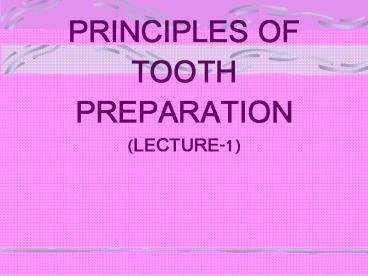PRINCIPLES OF TOOTH PREPARATION (LECTURE-1) - PowerPoint PPT Presentation
1 / 13
Title:
PRINCIPLES OF TOOTH PREPARATION (LECTURE-1)
Description:
Title: BIOMECHANICS OF TOOTH PREPARATION Author: ABC Last modified by: SMITA SINGH Created Date: 1/10/2005 6:32:58 PM Document presentation format – PowerPoint PPT presentation
Number of Views:990
Avg rating:3.0/5.0
Title: PRINCIPLES OF TOOTH PREPARATION (LECTURE-1)
1
PRINCIPLES OF TOOTH PREPARATION(LECTURE-1)
2
- CONTENTS-
- Tooth preparation is governed by the principles
of tooth preparation- - 1) Preservation of tooth structure
- 2) Retention Resistance
- 3) Structural durability
- 4) Marginal integrity
- 5) Preservation of the periodontium
(According to Shilinburg) - Definition The process of removal of diseased
and/or healthy enamel and dentin and cementum to
shape a tooth to receive a restoration
3
1. Preservation of Tooth Structure
- While replacing a lost tooth structure, a
restoration must preserve the remaining tooth
structure as much as possible. - Tooth structure is conserved by using the
following guidelines- - 1. Use of partial coverage rather than complet
coverage restorations. - 2. Preparation of teeth with minimum practical
convergence angle - (taper) between axial walls.
- 3. Preparation of the occlusal labial surface
so reduction follows the anatomic - planes to give uniform thickness in the
restoration.
4
4. Preparation of the axial surfaces so that the
tooth structure is removed evenly if
necessary, teeth should be orthodontically
repositioned. 5. Selection of a
conservative margin compatible with the other
principles of tooth preparation. 6.
Avoidance of unnecessary apical extension of the
preparation.
5
2. Retention Resistance RETENTION-
Resistance to removal of restoration in the path
of insertion.RESISTANCE-Prevention of
dislodgement of a restoration from apical,
oblique and horizontal forces.
- Factors for Retention-
- Degree of taper
- Freedom of displacement
- Length of preparation
- Substitution of internal features
- Factors for Resistance-
- Degree of taper
- Freedom of displacement
- Length width of preparation
- Leverage action from the oblique forces.
- Rotation around the vertical axis
6
- TAPER-
- The axial walls of the preparation must taper
slightly to permit the restoration to seat.i.e. 2
opposing external walls must gradually converge
ANGLE OF CONVERGENCE. - 2 opposing internal surfaces of the tooth
structure must diverge occlusally ANGLE OF
DIVERGENCE.
7
- The more nearly parallel the opposing walls of a
preparation, the greater should be the retention. - Most retentive preparation should be one with
parallel walls, but the parallel walls are
impossible to create in the mouth without
producing preparation undercuts. - An UNDERCUT - is defined as a divergence between
opposing axial walls, or wall segments, in a
cervical- occlusal direction.
8
- FREEDOM OF DISPLACEMENT-
- Retention is improved by geometrically limiting
the numbers of paths along which a restoration
can be removed from the tooth preparation. - Maximum retention is achieved when there is only
one path.
Limiting the freedom of displacement from
torqueing or twisting forces in a horizontal
plane increases the retention of a restoration.
9
- LENGTH-
- Occlusogingival length is an important factor in
both retention resistance. - Longer preparations will have more surface area
therefore will be more retentive . - The length must be great enough to interfere with
the arc of casting pivoting about a point on the
margin on the opposite side of the restoration.
10
- SUBSTITUTION OF INTERNAL FEATURES-
- It may not be possible always to use opposing
walls for retention. - Therefore, internal features such as the groove,
the box form, the pin hole can be substituted
for an axial wall or for each other.
11
- PATH OF INSERTION-
- It is an imaginary line along which the
restoration will be placed onto or removed from
the preparation. - It is of special importance when preparing teeth
to be fixed partial denture abutments, since the
paths of all the abutment preparations must
parallel each other. - Surveying visually- it is the primary means of
insuring that the preparation is neither undercut
nor over-tapered.
12
Leverage Action From The Oblique Forces
Rotation around the vertical axis
Width of the preparation
13
- REFERENCES
- Fundamentals of Fixed Prosthodontics, Herbert
T. Shillingburg - Contemporary Fixed Prosthodontics ,Stephen
F.Rosensteil































